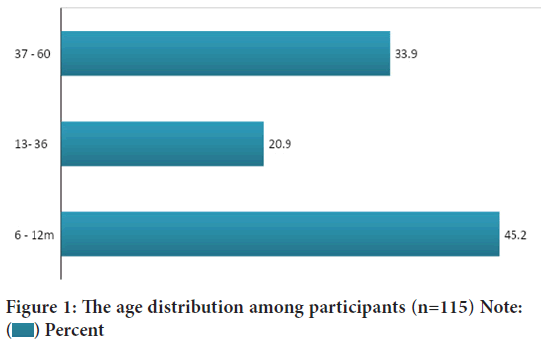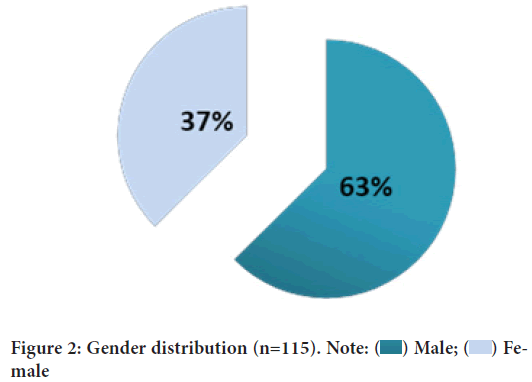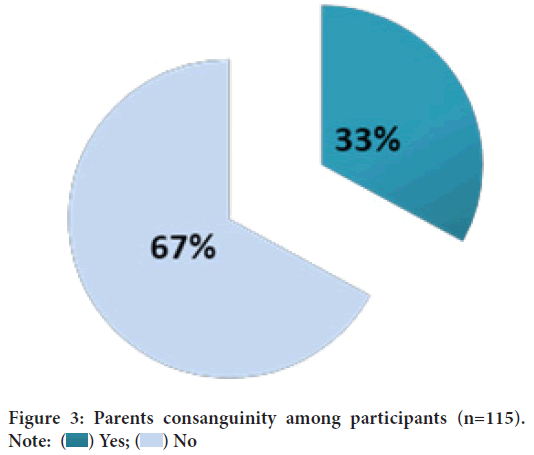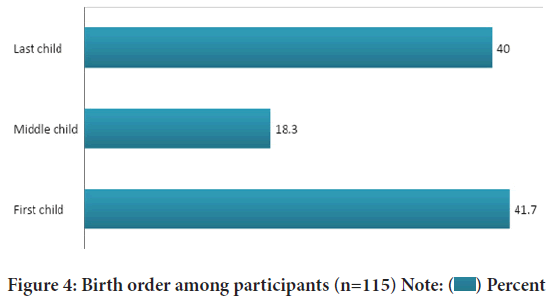Research Article - (2022) Volume 13, Issue 12
Abstract
Background: Febrile Seizure (FS) is one of the most common neurologic disorders in children. Electrolyte imbalance especially hyponatremia may have an important role in triggering the Febrile Seizure. The measure of serum electrolytes will be useful in predicting further seizures. This study aimed to investigate the effect of relative hyponatremia on the risk of recurrent Febrile Seizures.
Methods: This prospective study was performed on 115 children (6-60 months) with convulsions, at the pediatric department of Ibrahim malik teaching hospital. The serum sodium was measured immediately after abortion of seizures and each patient was followed for 24 hours for assessment of recurrence.
Results: Of the 115 children, 47 (40.9%) develop recurrent Febrile Seizures. Of those the majority were males 36 (76.6%) (p=0.01), 52 (45.2%) age less than 12 months (p=0.001), 26 (68.4%) have parents consanguinity (p=0.000), and were first born child 25 (53.2%). The mean serum sodium levels in patients with one and recurrent attacks, were 132.1, 136.1 meq/l, respectively (p=0.00).
Conclusion: The serum sodium level was ominously lower in the recurrence group compared to the non-recurrent group. Measurements of serum sodium levels and hyponatremia diagnosis have a key role in predicting the FC recurrence. Therefore, doctors should be careful during fluid administration to Febrile Seizure patients.
Keywords
Febrile Seizure (FS), Recurrence, Hyponatremia, Serum sodium
Introduction
Febrile Seizures are the most common neurologic disorder in children. It occurs in children between the ages of 6 months to 5 years with body temperature over 38°C and without any infection such as meningitis and encephalitis. It is classified into two types: Simple and complex seizures. Simple seizure is generalized tonic-colonic movements for less than 15 minutes without recurrence in the first 24 hours. Complex seizures occur more than once in 24 hours for more than 15 minutes and are focal. The degree of fever associated with Febrile Seizures is variable, and approximately 25% of events occur when the temperature is between 38℃ and 39℃ (Mittal R, 2015).
The incidence of FS is 5 cases per 1000 children annually (Shinnar S and Glauser TA, 2022). Two-four percent of children experience FS during the first 6 years of life and almost one-third of them have experienced recurrent episodes. Therefore, identification of the risk factors appears to be necessary to prevent recurring attacks (Salehiomran M, et al., 2018). Approximately 1/3rd of children with the first episode of Febrile Seizure will have an episode of recurrence; 10% will have 3 or more episodes of Febrile Seizures. The most cardinal risk factors are family history of FS and onset of first Febrile Seizure at less than 12 months of age. Two other definitive risk factors for recurrence of FS are the height of the temperature and the time interval between the onset of fever and the episode of seizure (Mayan M, et al., 2020).
Previously, Rutter N and O’Callaghan MJ, 1978 have suggested that a child who has had a Febrile Seizure and is hyponatremic might be more likely to have a subsequent seizure during the same illness. They have shown that a higher proportion of hyponatremic children (5 out of 50) had a further seizure compared with normonatraemic children (2 out of 113). It has been thought that it is unlikely that there is a straightforward relationship between Febrile Seizures and Hyponatremia (Rutter N and O’Callaghan MJ, 1978).
Abdalla AN and El Seed AM, 1986 conducted a study in Sudan that aimed to calculate the prevalence rate and see the association between FS and other variables like age, gender, socioeconomic status, and recurrence rate. The hospital prevalence of Febrile Seizures was found to be 1.8% and the mean age was 30. There was a preponderance of males being about two-thirds of patients. No particular social class was found to have a higher representation in children with Febrile Seizures. A family history of seizures was obtained in 51.4% of patients (40% febrile and 11.4% non-febrile). The only laboratory investigation found to be useful. All findings were conformed to those reported in the literature except for the following points: Male to female ratio was exceptionally high; higher percentages were also found for prolonged seizures (30%) and multiple seizures (47.2%). The youngest age group 6-12 months contained the highest number of patients (Abdalla AN and El Seed AM, 1986).
In January 2016, a prospective study was conducted in Amikora Pediatrics Hospital, Iran to compare different electrolyte levels and Febrile Seizures recurrence in the first 24 hours. The sample was divided into 3 groups: Simple Febrile Seizure (SFS), Complex Febrile Seizure (CFS), and seizure without fever. In each group, the serum sodium was measured at the beginning of the admission and followed for 24 hours, and electrolyte imbalance was evaluated in seizure recurrences. Data were analyzed using SPSS- 16. The results of the study: Out of the 334 children, 105 (31.7%) and 229 (68.3%) patients were female and male, respectively. The mean serum sodium levels in patients with SFS, CFS, and the control group were 136.64, 134.91, and 137.38 meq/l, respectively (potassium and calcium levels were in the normal range in summary). The serum sodium level was significantly lower in simple and complex seizures compared to the control group. Measurements of serum sodium levels and Hyponatremia diagnosis have a key role in predicting the FS occurrence and recurrence (Salehiomran M, et al., 2018).
There are many studies regarding hyponatremia and recurrence of Febrile Seizure but not a single one is conclusive about the relation.
Methodology
Study design and area
The study is prospective cross-sectional design. Ibrahim Malik Teaching Hospital is a national hospital provides medical care as well as medical education to students at medical colleges and other health institutions. It’s located in El Sahafa, South of Khartoum. The hospital comprises all medical specialties in addition to supporting units. The hospital capacity is 231 beds. The working staffs in hospitals are composed of doctors and other medical staff members, in addition to non-medical administrative staff as well as ancillary staff. The study will be conducted at the Pediatric Emergency Department which is composed of 29 beds short stay plus 4 beds as Pediatric High Dependency Unit (PHDU) and 10 beds in the nursery.
Study population
The study population will be pediatric patients aged 6 to 60 months who are attending the Emergency Department at Ibrahim Malik Teaching Hospital who presented with Febrile Seizures as defined below in the diagnosis criteria section.
Study period
The study period extended from January to March, 2022.
Inclusion criteria
Any Febrile Seizure patient aged 6 to 60 months attending the hospital during the study period.
Diagnosis criteria
Any convulsions (generalized or localized) in a child aged 6 to 60 months, not known to be epileptic or known case of any chronic illness, associated with fever due to infection (bacterial, viral, fungal or parasitic).
Exclusion criteria
• Children with preexisting neurological abnormality, or central nervous system infection.
• Seizure following trauma, drug or toxin intake.
• Children whom parent/guardian refused to participate in the study.
• Children with known chronic illness to (Diabetes mellitus, chronic kidney disease, hepatitis B, C-celiac disease and HIV positive patients).
Sample size
We assumed that the prevalence of Febrile Seizures to be 50%, so by using the formula:
N=Z2pq/d2
Where:
n: sample size
Z: is 1.96 (95% confidence interval)
P: prevalence (0.05) q: 1-p=(0.95)
d: the margin of error=0.05
Calculated sample size was=115
Sampling technique
Sampled patient will be chosen using simple random sampling.
Variables
Independent variable: Age, sex, parent’s consanguinity, birth order, and number of attacks. Dependent variables: Serum sodium level, serum potassium level, blood glucose level, body temperature.
Data collection method
Data will be obtained from blood samples drawn immediately after the convulsion subsided (for serum sodium) as well as information from the patient’s parents in Ibrahim Malik Hospital. The data will be collected using semi-structured questionnaire. The questionnaire consists of 2 sections: demographic data and laboratory results sections.
Questionnaire pretest: It will be performed on multiple patients on different days to increase the reliability. The procedure uses a cognitive interviewing approach because it provides a view of how respondents process their questionnaire responses.
Data collectors: A group of 5 data collectors (medical school graduates including myself) will be trained and provided with the knowledge required to complete the research data collection. Blood samples will be collected by the duty nurses and send to Ibrahim Malik Teaching Hospital laboratory for analysis. Serum sodium level less than 135 meq/L was considered as low sodium level (hyponatremia).
Data analysis: Data will be managed using Statistical Package for Social Sciences (SPSS) software version 25. Categorical data will be presented as percentages and frequencies, while continuous data will be presented as means and standard deviations. For inferential statistics, One-way analysis of variance will be used to test for differences in sodium levels among the groups, and Pearson correlation between continuous and categorical variables. 95% confidence intervals will be obtained and a p-value of less than 0.05 will be considered statistically significant.
Ethical considerations
• The ethical clearance from the institutional review board at El Neelain University.
• Permission from the Sudan ministry of health.
• Written consent from patient’s parents was obtained.
Results and Discussion
Recurrent Febrile Seizures
In the present study, it has been found that 40.9% of children with FS had experienced recurrence in comparison to Indriani A, et al., 2017 found that 37.6% had recurrent FS out of 154 patients with FS. In the study by Agrawal J, et al., 2016, 1/3 of children had recurrent Febrile Seizures among 92 children (Tables 1 and 2).
| Recurrence of Febrile Seizures (FS) | Frequency | Percent |
|---|---|---|
| No | 68 | 59.1 |
| Yes | 47 | 40.9 |
| Total | 115 | 100 |
Table 1: The recurrence of seizure among participants
| Variable | Single attack | Recurrent attacks | P-value |
|---|---|---|---|
| Age | |||
| 6-12 | 21 | 31 | 0.001 |
| 13-36 | 18 | 6 | |
| 37-60 | 29 | 10 | |
| Gender (P) | |||
| Male | 46 | 36 | 0.01 |
| Female | 32 | 36 | |
| Birth order | |||
| 1st child | 23 | 25 | 0.07 |
| Middle child | 16 | 15 | |
| Last child | 29 | 17 | |
| Parents consanguinity | |||
| Yes | 12 | 25 | 0 |
| No | 56 | 21 | |
| Total | 68 | 47 | 115 |
Table 2: Correlation between demographic data with FS recurrence
Age distribution
In this study, we looked at children aged 6 to 60 months who had a Febrile Seizures and discovered that children who were less than 12 months at the time of their first FS 52(45.2%) were the majority, 31(66%) had recurrent FS (p=0.001) which make age a very important factor in recurrent FS. Similarly, according to the findings of Ridha NR, et al., 2009, children who had their first FS before the age of 18 were 71.37 times more likely to get recurrent FS. Another study by Alwan YF and Hussein HJ, 2013, concluded that 67% of cases with recurrent FS were aged between 4 and 12 months (p=0.01) (Figure 1).
Figure 1: The age distribution among participants (n=115) Note:  Percent
Percent
Gender distribution
In the present study, out of 47 children with recurrent FS, 36 (76.6%) children with recurrence were males and 11 (23.4%) were females (p=0.01). Similarly, in a study by Agrawal J, et al., 2016 showed that 83% of children with recurrent FS were males and 17% were females (p=0.088) (Figure 2).
Figure 2: Gender distribution (n=115). Note:  Male;
Male;  Female
Female
Parent consanguinity and birth order
In this study out of 38 children of first-degree consanguineous parents, 26 (68.4%) (p=0) of them had a recurrence of FS which highlight the importance of genetic factors in susceptibility to recurrent FS (Figure 3).
Figure 3: Parents consanguinity among participants (n=115). Note:  Yes;
Yes;  No
No
Regarding birth order firstborn children were 48 (41%), 25 (52%) of them develop recurrent FS (p=0.070) which confirms the findings of an earlier study by Abdalla AN and El Seed AM, 1986, that chances are higher in first, and second-born children in the family (p<0.010) (Figure 4).
Figure 4: Birth order among participants (n=115) Note:  Percent
Percent
Serum sodium and FS recurrence
Among the children with recurrent FS in the present study, 35 (74.5%) had serum sodium level less than 135 meq/L with a mean of 132.1 (p=0) compared to 136.1 mean serum sodium levels in the non-recurrent group which confirm the findings of Jatuporn study concluding that Serum sodium levels in children with recurrent seizures within 24 hours (130.80 mmol/L) were significantly lower than in children with a Single Febrile Seizure (132.37 mmol/L, p-value=0.02) (Duangpetsang J, 2019). The findings contradict the findings of Ghafoor I, 2017 stating that the mean serum sodium of patients with Single Febrile Seizures was (137.91), while the mean serum sodium level of patients with recurrent Febrile Seizures was (139) and the mean serum sodium of the control group was (141.42) (Tables 3 and 4). The P-value of comparison between control and those with Single Febrile Seizures was significant (0.002), but the P-value of comparison between control and those with recurrent Febrile Seizures was not significant (0.813).
| Serum sodium | Recurrence | P-value | |
|---|---|---|---|
| No | Yes | ||
| <135 meq\l | 13 | 35 | 0 |
| ≥ 135 meq\l | 55 | 12 | |
| Total | 68 | 47 | 115 |
Table 3: The relation between serum sodium and FS recurrence
| Serum sodium | |||
|---|---|---|---|
| Mean | Standard Deviation | Minimum | Maximum |
| 134.55 | 5.494 | 115 | 158 |
Table 4: Mean and standard deviation of serum sodium levels among participants
Conclusion
We have studied 115 children having been diagnosed with febrile seizures and most of the children were aged less than 12 months. Male children were more commonly affected than females in the ratio 1.7:1. First and last-born children were more affected than middle born children. Among 115 children, 47 children (40.9%) had experienced a recurrent Febrile Seizure. In recurrent Febrile Seizures, most of the children had their first Febrile Seizure before their first birthday. Male children are more commonly affected by recurrence. Most children with recurrence were firstborn children and 25 of all cases of recurrence have parents’ consanguinity (mostly 1st-degree cousins). The serum sodium level difference between the recurrence and non-recurrence groups is statistically significant, with lower mean serum Na levels in the recurrence group, which confirms the research hypothesis.
Recommendations
More primary data studies are required for greater accuracy.
Analytical studies are also required to identify the risk variables for recurrence of Febrile Seizures.
Future research is needed to determine what preventive steps should be taken given before a Febrile Seizure recurrence.
References
- Mittal R. Erratum to: Recent advances in febrile seizures. Indian J Pediatr. 2015; 82(8): 772.
[Crossref] [Google Scholar] [Pubmed]
- Shinnar S, Glauser TA. Febrile seizures. J Child Neurol. 2002; 17(1): S44-52.
[Crossref] [Google Scholar] [Pubmed]
- Salehiomran M, Ebrahimzadeh H, Hajiahmadi M. The serum sodium levels and recurrence of simple febrile seizure during the first 24 hours in children. Caspian J Pediatr. 2018; 4(1): 278-281.
- Mayan M, Prabhu A, Saldanha P. A retrospective study of febrile seizures among children admitted in a tertiary care hospital. Int J Contemp Pediatr. 2020; 7(11): 2112-2114.
[Crossref]
- Rutter N, O'Callaghan MJ. Hyponatraemia in children with febrile convulsions. Arch Dis Child. 1978; 53(1): 85-87.
[Crossref] [Google Scholar] [Pubmed]
- Abdalla AN, El Seed AM. Febrile convulsions in Sudanese children. Sudan J Paediatr. 1986; 5: 49-66.
- Indriani A, Risan NA, Nurhayati T. Five years study of recurrent febrile seizure risk factors. Althea Med J. 2017; 4(2): 282-285.
- Agrawal J, Poudel P, Shah GS, Yadav S, Chaudhary S, Kafle S. Recurrence risk of febrile seizures in children. J Nepal Health Res Counc. 2016; 14(34): 192-196.
[Crossref] [Google Scholar] [Pubmed]
- Ridha NR, Nara P, Angriani H, Daud D. Identification of risk factors for recurrent febrile convulsion. Paediatr Indones. 2009; 49(2): 87-89.
- Alwan YF, Hussein HJ. Risk factors for recurrent febrile convulsions in children. Al-Kindy Col Med J. 2013; 9(2): 14-16.
- Duangpetsang J. Serum sodium levels predict the recurrence of febrile seizure within 24 hours. J Health Sci Med Res. 2019; 37(4): 277-280.
- Ghafoor I. Evaluation of serum sodium level in single and recurrent febrile seizures. J Sulaimani Med Coll. 2017; 7(4): 371-377.
[Crossref]
Author Info
Monzer Azhari Mahgoub Farah1* and Rahel G Mahari22Department of Pediatrics, Ahfad University for Women, Omdurman, Sudan
Citation: Farah MAM: Low Serum Sodium Level and Prediction of Febrile Seizure Recurrence
Received: 01-Nov-2022 Accepted: 25-Nov-2022 Published: 02-Dec-2022, DOI: 10.31858/0975-8453.13.12.885-888
Copyright: This is an open access article distributed under the terms of the Creative Commons Attribution License, which permits unrestricted use, distribution, and reproduction in any medium, provided the original work is properly cited.
ARTICLE TOOLS
- Dental Development between Assisted Reproductive Therapy (Art) and Natural Conceived Children: A Comparative Pilot Study Norzaiti Mohd Kenali, Naimah Hasanah Mohd Fathil, Norbasyirah Bohari, Ahmad Faisal Ismail, Roszaman Ramli SRP. 2020; 11(1): 01-06 » doi: 10.5530/srp.2020.1.01
- Psychometric properties of the World Health Organization Quality of life instrument, short form: Validity in the Vietnamese healthcare context Trung Quang Vo*, Bao Tran Thuy Tran, Ngan Thuy Nguyen, Tram ThiHuyen Nguyen, Thuy Phan Chung Tran SRP. 2020; 11(1): 14-22 » doi: 10.5530/srp.2019.1.3
- A Review of Pharmacoeconomics: the key to “Healthcare for All” Hasamnis AA, Patil SS, Shaik Imam, Narendiran K SRP. 2019; 10(1): s40-s42 » doi: 10.5530/srp.2019.1s.21
- Deuterium Depleted Water as an Adjuvant in Treatment of Cancer Anton Syroeshkin, Olga Levitskaya, Elena Uspenskaya, Tatiana Pleteneva, Daria Romaykina, Daria Ermakova SRP. 2019; 10(1): 112-117 » doi: 10.5530/srp.2019.1.19
- Dental Development between Assisted Reproductive Therapy (Art) and Natural Conceived Children: A Comparative Pilot Study Norzaiti Mohd Kenali, Naimah Hasanah Mohd Fathil, Norbasyirah Bohari, Ahmad Faisal Ismail, Roszaman Ramli SRP. 2020; 11(1): 01-06 » doi: 10.5530/srp.2020.1.01
- Manilkara zapota (L.) Royen Fruit Peel: A Phytochemical and Pharmacological Review Karle Pravin P, Dhawale Shashikant C SRP. 2019; 10(1): 11-14 » doi: 0.5530/srp.2019.1.2
- Pharmacognostic and Phytopharmacological Overview on Bombax ceiba Pankaj Haribhau Chaudhary, Mukund Ganeshrao Tawar SRP. 2019; 10(1): 20-25 » doi: 10.5530/srp.2019.1.4
- A Review of Pharmacoeconomics: the key to “Healthcare for All” Hasamnis AA, Patil SS, Shaik Imam, Narendiran K SRP. 2019; 10(1): s40-s42 » doi: 10.5530/srp.2019.1s.21
- A Prospective Review on Phyto-Pharmacological Aspects of Andrographis paniculata Govindraj Akilandeswari, Arumugam Vijaya Anand, Palanisamy Sampathkumar, Puthamohan Vinayaga Moorthi, Basavaraju Preethi SRP. 2019; 10(1): 15-19 » doi: 10.5530/srp.2019.1.3










